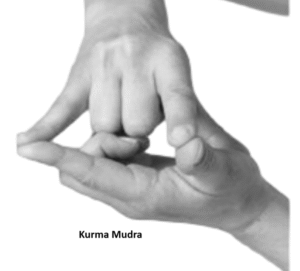Kurma Mudrā
Introduction
Kurma Mudrā, also called the Tortoise Gesture, is a symbolic yogic hand gesture that represents withdrawal, stillness, and deep inner stability. Just as a tortoise withdraws into its shell for protection and rest, this mudra helps practitioners withdraw their senses (pratyahara) and turn their awareness inward.
It is widely practiced in Hatha Yoga, Mudra Therapy, and Meditation for calming the nervous system, improving breathing, and deepening concentration.
Meaning
Sanskrit Etymology:
Kurma = tortoise.
Mudrā = seal or gesture.
Thus, Kurma Mudrā means “the gesture of the tortoise”, symbolizing withdrawal, steadiness, and protection.
In yogic symbolism, the tortoise represents longevity, patience, and the ability to endure challenges by retreating inward.
How to Perform (Method of Practice)
Steps:
Sit in a comfortable posture (Padmasana, Sukhasana, or Vajrasana).
Left hand – with palm facing up, fold middle, ring and little fingers into the palm.
Right hand – with palm facing down, bend the middle and ring fingers into the palm.
Extend your right thumb and rest it on the base of your left wrist. Join the end of the right index finger to the left thumb. Then join the tip of the right-hand little finger with the left-hand index finger.
Close your eyes and relax the shoulders.
Focus on slow, deep breathing — imagining yourself withdrawing into your own “inner shell” like a tortoise.
Hold for 10–15 minutes during meditation or pranayama.
Benefits
Physical Benefits
Regulates respiratory system, useful in asthma, bronchitis, and shallow breathing.
Calms palpitations and stabilizes heart rhythm.
Helps relieve fatigue, lethargy, and low energy.
Supports longevity by improving oxygenation and vitality.
Mental & Emotional Benefits
Promotes inner calm and resilience.
Helps manage stress, anxiety, and restlessness.
Increases patience and steadiness of mind.
Encourages emotional balance and self-control.
Spiritual Benefits
Aids in Pratyahara (withdrawal of senses)—a key stage in Raja Yoga.
Deepens meditation by directing awareness inward.
Strengthens connection with Anahata (Heart Chakra), enhancing compassion and peace.
Symbolizes the yogic ability to remain unaffected by outer disturbances.
Contraindications
Should not be practiced in cases of severe depression (as withdrawal may worsen symptoms).
Those with very low blood pressure should practice cautiously, as it induces relaxation.
Not recommended immediately after heavy meals.
Anatomy & Physiology
Engages the respiratory system: improves lung capacity and oxygen exchange.
Activates the parasympathetic nervous system, lowering stress hormones (cortisol).
Affects the cardiac rhythm by slowing heart rate and promoting balance.
Stimulates immune function by reducing oxidative stress.
Kinesiology
Involves interlacing of fingers and pressing thumbs → light isometric contraction of hand and forearm muscles.
Provides a neuromuscular feedback loop that enhances inward focus.
Symbolically, the interlaced hands represent the tortoise shell, a protective shield.
Neurology
Promotes neurocalmness by stimulating the vagus nerve.
Encourages alpha brainwave activity, aiding relaxation and meditation.
Balances autonomic nervous system, shifting dominance toward rest-and-digest mode.
May improve neuroplasticity, supporting emotional regulation and resilience.
Duration of Practice
Beginners: 5–10 minutes daily.
Intermediate: 15–20 minutes during meditation.
Advanced: Up to 30–45 minutes, especially for pratyahara and pranayama practices.
Best times: early morning or before sleep.
Counter Mudra
Prana Mudra – restores energy after inward withdrawal.
Gyan Mudra – enhances concentration and wisdom.
Anjali Mudra – balances emotional energy and promotes openness.
Conclusion
Kurma Mudrā is a powerful yogic gesture that teaches withdrawal, stillness, and resilience, much like the tortoise it symbolizes. It is especially beneficial for calming the mind, stabilizing breath, and deepening meditation. Practiced regularly, it builds inner strength, patience, and the ability to remain centered amid life’s challenges.
FAQ
Q1: Can Kurma Mudra help with anxiety?
Yes, it reduces stress by activating the parasympathetic nervous system.
Q2: How long should I practice daily?
Start with 10 minutes and gradually increase to 20–30 minutes.
Q3: Is it safe for beginners?
Yes, very safe if practiced moderately.
Q4: Can it be combined with Pranayama?
Yes, especially with slow breathing techniques like Anulom Vilom or Bhramari.
Q5: Does it have spiritual significance?
Yes, it represents pratyahara, helping withdraw the senses for meditation.
References
Gertrud Hirschi – Mudras: Yoga in Your Hands.
Swami Satyananda Saraswati – Asana, Pranayama, Mudra, Bandha.
Lilian & Joseph Le Page – Mudras for Healing and Transformation.
Mallinson, James & Singleton, Mark – Roots of Yoga.
Kamlesh Patel – The Heartfulness Way.
